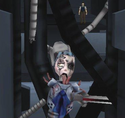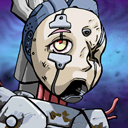Shinatama: Difference between revisions
m (link fix) |
m (link fix) |
||
| Line 37: | Line 37: | ||
==Resurrection and second death== | ==Resurrection and second death== | ||
[[Image: | [[Image:Zombie Shinatama.png|right|125px]] | ||
Griffin had known from the beginning there was a high possibility the Konoko would spiral out of control, and had planned accordingly. He had designed the [[Omega Vault]] bunker complete with a Deadly Brain frame, and retrieved the damaged remains of Shinatama from the explosion site. He had her wired into the frame, giving her access to the bunker's defenses and using her familiarity with Konoko as a critical advantage. | Griffin had known from the beginning there was a high possibility the Konoko would spiral out of control, and had planned accordingly. He had designed the [[Omega Vault]] bunker complete with a Deadly Brain frame, and retrieved the damaged remains of Shinatama from the explosion site. He had her wired into the frame, giving her access to the bunker's defenses and using her familiarity with Konoko as a critical advantage. | ||
Revision as of 21:42, 17 December 2023
|

|
A robotic assistant specifically designed by the TCTF to interface with Konoko, the pink-haired Shinatama is one of the most tragic characters of Oni.
Development
In the early phase of Oni's development, Shinatama might have been intended to be a Ghost in the Shell-esque cyborg with a whole-body transplant:
Factory made as a high-speed computer interface she has a human brain but a mechanical body. |
| Early Story |
During Hardy LeBel's creation of the final story, this transitioned to the concept of SLD technology, where Shinatama is 100% artificial and her cybernetic brain is trained using a human model (Konoko).
The word "shinatama" refers to a type of puppet from Edo-era Japan that performed tricks, for example making a ball disappear. The word is intended to convey juggling, sleight-of-hand, or concealment. As Shinatama is a "doll" that must "juggle" a large amount of data while interfaced with Damocles and Konoko, the name seems appropriate in-universe. Out-of-universe, it could be just as fitting to see her name as representing concealment….
Advisor to the heroine
Initially, Shinatama acted as the TCTF's handler to their field agent Konoko via a neural link. Unbeknownst to Konoko, Shinatama was also assigned the task of monitoring the state of her Daodan Chrysalis. It was later discovered that she had been downplaying the advancement of the Chrysalis in her reports to the TCTF in order to protect Konoko.
Shinatama alluded to the Chrysalis indirectly by telling Konoko that hyposprays would affect her differently than other people, informing her of the overpower effect. She then asked Konoko not to tell Griffin that she had shared this information, indicating their relationship to Konoko was more than a professional one. Her youthful personality was demonstrated by her panicking when the Deadly Brain flooded the Public News Net with images of itself.
Syndicate assault
Soon after the incident with the Deadly Brain, Muro led a Syndicate raid of Vago Biotech to obtain "experimental gene surgery equipment", with Barabas guarding the entrance. Shinatama continued her role as advisor to Konoko, but of particular interest was the fact that the SLD manufacturing process was completely explained in the lab's data consoles. Muro and his crew escaped with the equipment, Konoko hot on their trail.
When the chase led Konoko to the airport, Shinatama reported, horrified, that Muro and his troops were killing civilians at an alarming rate. Konoko managed to follow Muro and plant a homing device on his escape plane. Muro, however, was informed that she was neural-linked to an SLD, prompting him to conduct an immediate assault on the TCTF headquarters.
Kidnapped, tortured, and destroyed
A massive group of Strikers, Mad Bombers, and Furies led by Barabas assaulted the TCTF headquarters with astonishing speed and precision. Barabas himself managed to reach Shinatama, ripping her out of her alcove in the main computer. Konoko rushed to save her, only to see her taken away by helicopter.
The SLD was taken to a nearby Atmospheric Conversion Center by Muro, who connected her to an electric generator in order to torture her. He amusedly commented that she wasn't programmed with a limit to the pain she could feel. Having gotten whatever information he wanted or having lost interest in her, Muro left Shinatama in a highly damaged state. Konoko, who had come to rescue what she considered her only friend, was unable to move her without further damaging her.
Shinatama attempted to inform her about the Chrysalis and its impact, but only managed to pass on Konoko's real name, Mai Hasegawa, and the fact that there was something inside of her called a Chrysalis, before she received a self-destruct signal from TCTF command. She was able to slow it down, allowing Konoko a chance to escape before the explosion of her Xiox mechanism. She was presumed dead, but Griffin would have other plans for her.
Resurrection and second death
Griffin had known from the beginning there was a high possibility the Konoko would spiral out of control, and had planned accordingly. He had designed the Omega Vault bunker complete with a Deadly Brain frame, and retrieved the damaged remains of Shinatama from the explosion site. He had her wired into the frame, giving her access to the bunker's defenses and using her familiarity with Konoko as a critical advantage.
When Konoko confronted Griffin, he retreated to the bunker, forcing her not only to combat TCTF agents to reach him, but to destroy her friend as well in order to deactivate the Omega Vault's defense measures. Shinatama, aware that she was being forced to kill the person she viewed as a sister, begged for death while Konoko worked to sabotage the Deadly Brain frame through connected consoles. Once this was accomplished, Shinatama broke free of the frame, walking toward Griffin slowly (the best that her skeletal body could manage). Griffin shot her.
Shinatama Evolved
Shinatama Evolved is a custom character concept developed by Samer. The idea is Shinatama got rebuilt or resurrected into a more combat-capable body, perhaps as a way for Griffin to redeem himself after Konoko spared his life in the bunker.
Added value
It is interesting to note that the only being Konoko seems to have ever cared for (with the near-exception of Kerr) is: a) not really human; b) basically a part of Mai herself.
Simulated life
The SLD project is an attempt to recreate human physiology with artificial materials.
Dolls are grown by implanting micromechanical fabrication cells in large molds containing a mass of materials we call "prototissue".

|
SLDs are basically 3D-printed from within a material soup. They are meant to simulate many biological functions while not using classical biological materials (if at all).
- Classical biological materials are prone to rot away because they contain carbon.
Besides that SLDs feature few mechanical-like parts (skeleton) and electronic parts. This is emphasized by the term "doll" in SLD. This is to make them stronger than humans and let them easily interact with computer systems.
SLDs fill the gap between robotics and synthetic biology.
Most care was given to recreate human skin and the brain.
Shinatama is likely over 10 years old which could mean that Vago Biotech is at the edge of creating much more advanced SLDs now.
Human-primed
One thing we still cannot do is create an artificial system that adequately simulates the processes of the human mind. Instead SLDs contain a behavioral framework patterned on donor brain engram data fed into the system during its formation.
SLD brains mimic real neural networks. The initial setup of the synthetic neurons is based on scans of a human brain ("brain engrams").
This core personality is then given a chance to develop a unique neurolattice while experiencing accelerated streaming sensory feeds.
The approximately recreated personality is then trained to become more complex. The synthetic neural networks continue to learn and grow in a "senseloop".
- Shinatama might be special. In order to mirror Mai's development in best possible quality the TCTF could have demanded that her brain gets fabricated as much of a copy as possible - and so they are more guaranteed to get along. Soul sisters. Mai shares all her inputs with Shinatama. In theory they are running in sync. The problem is Shinatama does not grow up.
Since the materials are not biological this process can happen at unhuman speeds.
The end result is an artificial brain that is even able to show emotional patterns.
Typically, SLDs grow up in the social context and own belief that they are just better androids - tools to aid humans. They do not question their existence and therefore human overseers are most often not confronted with their ("simulated") free will. (There is no good reason for why not a free will could emerge from artificial neural networks if they are complex enough.)
Backup of Mai's innocence
In a way, while the human Mai got corrupted by her upbringing at the TCTF (as a "violent cop") and the implantation of the Daodan Chrysalis (which further catalyzed violence), Shinatama retained her innocence integrally through it all. Interesting point is that that innocence, too, was no one else's but Mai's.
Thus Shinatama can be seen as a backup of Mai's "true nature", before her personality got alienated by her adolescence, early adulthood, life at the TCTF, and Daodan symbiosis. Her death would mean the complete destruction of that backup.
Violent nurturing
Not only is Shinatama an extract of Mai's nature, she was also directly affected by Mai's nurturing, except for the most physical part of it (field action) and of course the Daodan symbiosis. "I've seen everything you've seen, felt everything you've felt".
If you think of Shinatama as a backup of Mai, then Shinatama's point of view is a bit disturbing: it's as if the innocent Mai was following the evolution of an increasingly messed-up projection of herself, live, non-stop, in subjective view and in such detail that she's virtually right there in the middle of the action, where people are killed and things are blown up.
Thus, another characteristic trait of Shinatama's innocence is that she's in a non-stop senseloop made of the violence actually encountered and generated by Mai: the human she was patterned after.
Shinatama never killed anyone, and still her existence is filled with that half-virtual violence. Violence unto Mai is violence unto Shinatama. Violence by Mai... for Shinatama, is like seeing through the eyes of a maniac/murderer, seeing her own hands kill people, not being able to look away, not being able to do anything but watch.
In that, Shinatama is very different from other legal SLDs (who coordinate firemen and such). Not only does she oversee the operations of violent cops, she sees through the eyes of one such violent cop, who additionally happens to be a projection of herself. A projection in space, but also in time.
Not growing up
We don't know at what point Shinatama was brought into existence. It would seem that she and Konoko have known each other for a while, possibly since the very moment Mai was "adopted" by the TCTF.
Shinatama's body doesn't age, and her emotional patterns had no reason to evolve much, either (save for the violent nurturing above). If she was patterned after Mai when Mai was, say, seven... then that explains her "annoying" childish ways.
It also brings about an interesting consideration... At the start of Griffin's Daodan project, Mai and Shinatama are like twin sisters (more like clone sisters, actually). It doesn't take long, however, until Mai outgrows Shinatama and becomes a "big sister" for her. Eventually, we end up with a Mai about three times the age of the one who used to be her biotech twin.
That's an original way to look at their "family" relationship, and how it evolved over time. How did Mai feel about "leaving Shinatama behind"? How did Shinatama feel about Konoko "drifting away" from her?
More than family
There's a complicated emotional bond between Mai and Shinatama, that goes beyond partnership or even the usual concept of family. No wonder Shinatama "fixated" on it.
The way Mai and Shinatama share nature and nurturing, one of them physically implicated and evolving, the other almost out of space and out of time, is an appealing element of Shinatama's background, and also of Mai's.
Free will and rationality
While subject to something like Asimov's Three Laws of Robotics, it is clear that nothing's clear about an SLD's degree of initiative, free will, or even rational thinking (which is the only guarantee of predictability and control).
Thus an SLD can not, technically, disobey a direct order, but it can circumvent an ill-stated directive. And Shinatama had been doing just that when falsifying her reports on Konoko: that would mean that lying, for instance, is not ruled out by an SLD's design.
As for irrationality: for example, there was an objective reason why Shinatama disobeyed Griffin in the Omega Bunker (emergency overrides had been switched off without Griffin knowing), but why did she start walking towards him in the first place?
That "Omega Security Mode" just doesn't make any sense... It would seem that Shinatama's complexity, her uncommon emotional background, her inner conflict (between innocence and violence), and possibly Mai's "conflicting input", made her behave in an irrational way.
That goes back to the Daodan as loss of control. Extremely sophisticated individuals such as legal SLDs, by their very depth, are prone to escaping prediction and control.
However, if the scientists were to master every aspect of Shinatama's design, she wouldn't have been more efficient than an average computer or android. There's an unavoidable risk here, and the best one can do is to acknowledge it.
One characteristic of the human mind is abstract thought, and if some of it filters into an SLD's brain (and it does), why couldn't they get subjective, or illogical, or crazy?
That "excessive humanity" in man-made machines is often addressed in sci-fi. Non-trivial approaches are rare, though. All the more appealing to read a lot of complicated stuff into the SLD concept...
Pain and death
How much can Shinatama suffer and how many times can she die?
Whether she experiences actual bodily harm, or is subjected to Konoko's, she can take a lot more than a regular human being, or so it seems.
However, it's not clear whether her "innocent nature" is unaffected by violence, pain and, ultimately, death. Does she remain an accurate backup of the still-human, seven-year-old Mai no matter what happens, or is a little bit of Mai (and humanity) stripped away every time Shinatama experiences stress, pain, physical harm or "death"?
If it's the latter, just what happens to Shinatama if her synthetic, simili-human body and brain is damaged, then completely destroyed, and all that remains is her projection in "cyberspace" (to which she was wired all her life)? What could be the features of that projection?
Disembodied Soul
(apart from theology, the name echoes a humorous concept of Bungie's : this is not too funny, though...)
Without an anchor to her pattern donor or to humanity as a whole, without even her synthetic brain (which made her apt to experience human emotions after having been "taught" what they were), there's a good chance that Shinatama will distance herself from mankind and become more calculated, bitter, cold and cruel.
Her free will, and her ability to circumvent orders, will most probably remain, but without a "sister soul", her motivations will be somewhat disconnected, "by default", from human-like emotional stakes... She will go progressively out of phase with mankind, becoming a side observer and a critic (or worse) rather than "part of it".
Hikari
Owldreamer's original character Hikari is an Oni 2 concept for Shinatama. Now an electronic ghost who has created an android avatar of herself, Hikari can be seen as the disembodied, seen-it-all Shinatama's anchor to humanity and to Mai. Hikari's own inner universe is yet another field of investigation, but she's already a powerful character through what she means to Shinatama: without an anchor such as the neural link to Mai, or an avatar such as Hikari, Shinatama is the Disembodied Soul described above.




